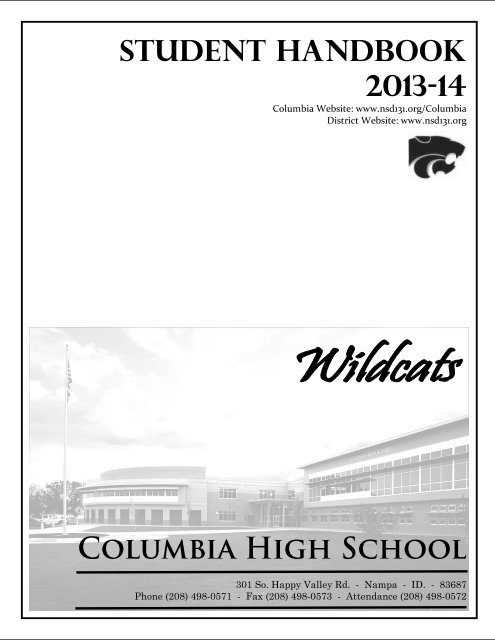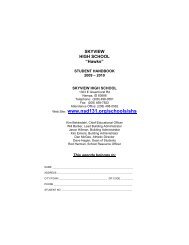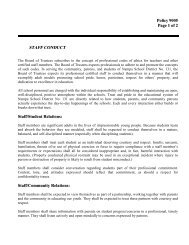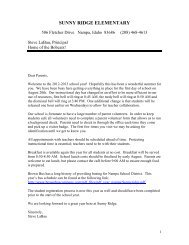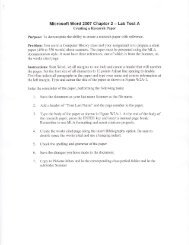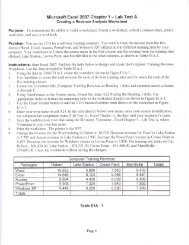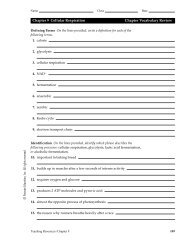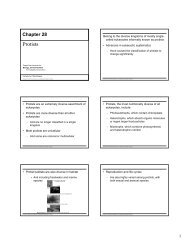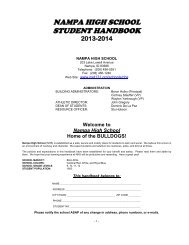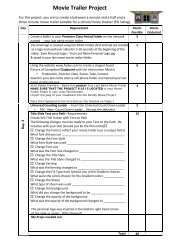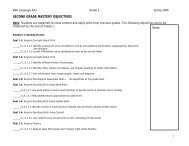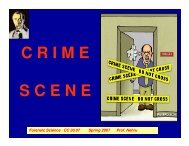Columbia High School - NSD Main
Columbia High School - NSD Main
Columbia High School - NSD Main
Create successful ePaper yourself
Turn your PDF publications into a flip-book with our unique Google optimized e-Paper software.
President – Greg PalmerBooster meetings are held the second Saturday of each month at the Flying M Coffee Shop,1314 2 nd St. South, Nampa.Project Graduation:The CHS Project Graduation committee is for volunteer parents who want to help plan and beinvolved in the all-night drug and alcohol free celebration honoring our graduating seniors the night ofcommencement.<strong>School</strong> Telephone Numbers<strong>Columbia</strong> <strong>High</strong> <strong>School</strong>…………………………. 498-0571Skyview <strong>High</strong> <strong>School</strong> ................................ 498-0561Nampa <strong>High</strong> <strong>School</strong> .................................. 498-0551Ridgeline Alternative <strong>High</strong> <strong>School</strong>…………498-0559Teen Parent (Parkview)............................ 498-0558Alpha 1...................................................... 468-4775Gateways……………………………………….. 498-0557East Valley Middle <strong>School</strong> ........................ 468-4760Lone Star Middle <strong>School</strong>……………………….468-4745South Middle <strong>School</strong> ................................ 468-4740West Middle <strong>School</strong> ................................. 468-4750Centennial Elementary ............................ 468-4627Central Elementary .................................. 468-4611Endeavor Elementary .............................. 468-4629Franklin D. Roosevelt Elementary ........... 468-4620Gateways……………………………………………..498-0557Gateways (Elementary)………………………..498-0567Greenhurst Elementary ........................... 468-2771Iowa Elementary ...................................... 468-4621Liberty Charter <strong>School</strong> ............................. 466-7952Lake Ridge Elementary………………………… 468-4626New Horizons Elementary…………………….468-4623Owyhee Elementary ................................ 468-4616Park Ridge Elementary ............................. 468-4622Ronald Reagan Elementary ..................... 468-4619Sherman Elementary ............................... 468-4628Snake River Elementary ........................... 468-4614Willow Creek Elementary ........................ 468-4617District Office............................................ 468-4600Warehouse (Custodial/<strong>Main</strong>tenance) ..... 468-4605<strong>NSD</strong> Technology Center ........................... 468-4604Nutrition/Food Service ........................... 468-4607Brown Bus Company ................................ 466-4181Dear Student and Parent,This handbook is intended to share information helpful to parents and students. Many of the provisions inthe handbook are required to be shared with you under state or federal regulations. Unfortunately, the
sheer volume and character of some of the provisions may give the impression of an overly formal schoolsystem rather than a friendly, personal one.Therefore, our school board, district administration and school staff, in sharing this handbook, would likeyou to understand that we seek to cultivate an active partnership with you.This handbook is intended to enrich this partnership with students and parents through helping createunderstanding of expectations for student conduct. The information in this handbook was the bestavailable at the time it was published and is subject to change at any time during the school year. Changeswill be announced to students and students are accountable for those changes.What is more important than these written provisions, however, is maintaining open communication withyou on issues affecting the progress and growth of students.Administrators and staff pledge to work cooperatively with you as parents and students, to make theeducational experience in the Nampa <strong>School</strong> District positive and successful.Regards,<strong>Columbia</strong> <strong>High</strong> <strong>School</strong> AdministrationTardy<strong>Columbia</strong> <strong>High</strong> <strong>School</strong> Site Specific PoliciesStudents may be marked tardy if they are not in their seat within their appropriate classroom when thetardy bell rings. Any tardy is unauthorized unless a staff member has detained the student and a note hasbeen issued excusing the tardy. With a legitimate pass, no tardy is recorded. The teacher keeps recordsof tardies. Any student 15-30 minutes tardy will be marked “very late” (VL); a “very late” tardy counts for2 tardies on the scale below. All teachers will use the guidelines of the school-wide tardy policy as theyissue appropriate consequences.The school-wide tardy policy is as follows:• 1 st Tardy: Warning issued.• 2 nd Tardy (or 1 st VL tardy): Teacher-assigned consequence.• 3 rd Tardy: Teacher-assigned lunchtime, after-school detention, or similar consequence. Parentcontact is made – teacher explains consequences for further tardies.• 4 th Tardy (or 2 nd VL Tardy): Referral to Dean of Students or administration; assignment of one-hourafter-school detention or other consequence.• 5 th Tardy (or 3 rd VL Tardy): Referral to an administrator and assignment of one Saturday <strong>School</strong>, 1 dayof out-of-school suspension or other consequences.Electronic DevicesNeither Nampa <strong>School</strong> District 131 nor its agents accept liability for the potential loss, theft, or damage toelectronic devices (cell phones, smart phones, smart tablets, laptops, music players, iPods, MP3 players,and any other wireless or electronic device) or such items on school grounds. We continue to urgestudents to leave all valuables at home, but understand that cell phones are often used for emergencypurposes by students and their parents. Parents of students that decide to bring these devices to schoolare encouraged to discuss a plan that promotes security and helps prevent opportunities for theft,breakage, etc.Students are allowed to use their electronic devices during non-class time in the designated commonareas on campus (cafeteria, bathroom, patio, etc.). However, if this use results in the disruption of theeducational process, it will be considered a violation of the electronic policy.Electronic devices must be turned to the “off” or “silent” position during class time, unless deemedotherwise by the teacher - within that specific classroom. Teachers may choose to utilize these devices(at specific times; for specific activities), or may continue to prohibit them. Their classroom-specific rules
must describe their use [or non-use] of electronics – as well as any teacher-specific consequences theymay have for their misuse. Students are not required to have any of these devices in our schools.Most infractions involve students disregarding the guidelines of when and where these devices can beused. While these are not considered severe behaviors, repeated violations will carry increasingly seriousconsequences. The progression below lists consequences for students that choose to use electronicdevices during prohibited times or in prohibited places on campus. These consequences will be assignedat the discretion of the Dean of Students and other administration.• 1st incident - Item secured with campus security team and returned to student after school.• 2nd incident - Item secured with campus security team; parent/guardian contacted. Student isassigned one lunch detention. Device returned to student after school.• 3rd incident - Item secured with campus security team; parent/guardian contacted. Student isassigned one after school detention. Parent/Guardian must pick up device from school.• 4th incident- Item secured with campus security; parent/guardian contacted. Student is assigned twoafter school detentions. Parent/Guardian must pick up device from school.• 5th incident - Item secured with campus security; parent/guardian contacted. Student may besuspened. Parent/Guardian must pick up device from school during re-entry conference arrangedwith Dean of Students.More serious infractions involving student-use of electronic devices (i.e. cheating, pornography, cyberbullying,gang-related usage, “sex-ting”, etc.), will likely carry one or more of these, “severe clause”consequences (or other consequences listed in the “Behavior” section of this handbook) as deemednecessary by administration:• unique restrictions placed upon student’s ability to use technology in school• further use of technology only under the direct supervision of staff• complete suspension of use of technology within CHS for the remainder of the school year• school-assigned disciplinary consequences – i.e. detention, suspension, etc.• police intervention/ other legal action (when deemed necessary)• consequences that may include (but not be limited to) any single or combination of theaforementioned consequences aboveHat Policy• Hats must be school-appropriate and must be removed at a teacher’s request within that teacher’sclassroom. Hats may be confiscated by school officials anytime they are deemed as inappropriate forschool, if they become a distraction, or if students refuse to remove them in classes where prohibitedunder teacher-classroom rules.CounselorsLillena Pitcock Jason Hoyt Mike ChavezLast Names A-G Last Names H-P Last names Q-ZDISTRICT POLICIES FOR NAMPA SCHOOL DISTRICT HIGH SCHOOLS2013‐2014(Please see our school’s unique policies in the previous section.)Section I ‐ General Information• Associated Student Body (ASB) ID Cards• Athletic Policies & Standards• Buildings & Grounds• Bus Service/Transportation1. To and From <strong>School</strong>2. Activity Transportation & Travel Requirements• Cafeteria
• Communications• Dances• Driver’s Education• Driving/Parking• Food/Drink• Foreign Exchange Students• Internet/Computer Use Policy• Library/Media Center• Lockers• Severe Weather Closure• Student Records & Transcripts• Confidentiality of Student Records• Rights of Parent(s) or Student(s) to review records annual notice• Directory Information -- Annual Notice• Release of Information to Institutions of <strong>High</strong>er Education and the Military -- Annual Notice• Media & district, school & other print, video & electronic publications -- Annual Notice• Emancipated Students• Textbooks\Library Books• Teacher & Aide Qualifications, Right to Know• VisitorsSection II ‐ Academic Guidelines• Advanced Placement Exams• College Testing Information• Commencement/Graduation Exercises• Early Graduation• Enrollment & Withdrawal Procedures• Final Exam Make–Up Procedures• Grade Reporting• Grade Point Average• Graduation Requirements• Honor Roll• Section 504 Notice2011-12 – Rev. April 2011Section III – Attendance• Absences1. Parent reporting absences to school2. <strong>School</strong> reporting absences/truancy to parents3. Monitoring Absences, Consequences & Possible Loss of Credit4. Codes for Absences5. Make-Up Work6. Truant7. Excessive or Chronic Absences8. Denial of credit appeals process• Campus access1. Closed Campus2. Open PeriodSection IV‐ Behavior Expectations/Discipline Policies and Procedures• Behavior Expectations• Discipline Process & Administration Referral• Mischievous Behavior• Severe Behavior• Consequences• Bullying• Confiscated Material• Demeaning Language• Discrimination• Dress Code• Drug-Free Policy
• Electronic Devices• Fighting• Gangs & Hate Groups• Hall Conduct & Passes• Hazing• Plagiarism• Racial/Ethnic/Sexual Harassment Policy• Procedures to Handle Complaints of Discrimination• Procedures to Handle Sexual Harassment and/or all Other Types of Harassment• Search and Seizure• Theft• Trespassing/Non-student Loitering• Weapons Defined & Zero Tolerance PolicySection V ‐ Health & Emergency Policies• Emergency Information Form• Emergency & medical treatment• Immunization• Insurance• MedicationSection IGeneral InformationAssociated Student Body (ASB) ID CardsThe Nampa <strong>School</strong> District No. 131 provides all high school students an ID card. The first card is free. Replacementcards are $5. The ID card is used throughout a student’s high school career and serves three important purposes:• A Library Card, which entitles a student to check out materials, textbooks, and/or to use the computers.• A Lunch Debit Card, which allows a student to pre-pay for lunches and avoid carrying cash.• An Identification Card, which students are asked to carry with them at all times and may be asked to show it toany school personnel upon request to help ensure the safety of our campuses.Athletic Policies & StandardsCopy available in the Students Services Office.Buildings & GroundsOur campus reflects the pride we have in our school. Care of the buildings and grounds is the responsibility of allstudents and staff. In order to maintain a clean, attractive campus, we ask that students eat and drink in designatedareas and put trash in the proper place.Bus Service/Transportation1. To and From <strong>School</strong>Students residing in Nampa <strong>School</strong> District No. 131 who live more than 1.5 miles from school or in a safety busingzone are eligible for transportation to and from school. Please contact Brown Bus Co. at 466-4181 or visit its websitehttp://www.brownbuscompany.com/ for bus stop locations and bus numbers. Students using open enrollment arenot eligible for bus transportation. During the school day, our district provides shuttle service among the high schoolsfor students to access classes and programs.2. Activity Transportation & Travel RequirementsThe following rules apply to extra-curricular trips:• The school district provides transportation for participants to and from the location of the program or activityduring the normal school day of 7:30 am to 3:00 pm.• The school district will not provide transportation to other high schools within the Nampa <strong>School</strong> District foractivities outside the school day (football and track teams are exceptions – transportation will beprovided for those activities within <strong>NSD</strong>).• When transportation is not provided, school officials and/or coaches cannot help arrange or providetransportation.• Participants must be transported by district transportation to and from athletic events scheduled outside thecity.• Students may ride home from an event with parents if permission is granted by the coach, and parents havesigned their student out.• Particular programs or activities warrant the use of private carriers if the proper owner-operator vehicle form iscompleted and on file in the Athletic Director’s office.
CafeteriaThe cafeteria provides breakfast, lunch, and other Ala Carte items for the convenience of students. Breakfast is free.Meal prices are available on our website or from the cafeteria. Applications for free or reduced price lunch may beobtained from either the kitchen or the administration office. ASB cards are used as a debit card to pay for meals.Parents are encouraged to pre-pay meals for the students using www.mynutrikids.com. Students are asked to becourteous and not cut in line and return trays and trash to the proper place.The Healthy Hunger Free Act was signed into law in December, 2010. One of the requirements of this federal law isthat school districts are required to charge students for paid meals at a price that is on average equal to thedifference between free meal reimbursement and paid meal reimbursement. Since the free meal reimbursement iscurrently $2.51, our current meal prices are lower and must be raised. For 2012-13, the school lunch prices will beraised a nickel; elementary prices will be $1.90 and secondary prices will be $2.15.CommunicationsWe want to keep you updated about your student’s progress and of school events. Please remember when yourcontact information changes to let the school know. This includes your phone numbers, address, and email. We willuse this information to communicate to you throughout the school year and during emergencies.Here are the main ways we strive to keep you informed:• News – We produce daily announcements that are shared with students and may be emailed to parents. Pleasemake sure we have a current email address for your family. As funds allow, we may also mail home newsletters.We also post information on our school’s website and encourage you to check it frequently.• Grades and progress reports – These reports can be found on Power<strong>School</strong>. For specific dates, please checkour schedule for the year.• Answering your questions – Your questions and concerns are important. We invite you to contact your child’steacher or our school administration by note, phone message, or by e-mail. E-mail is the fastest way to reach ateacher or administrator. If you need an email address please visit our website, use Power<strong>School</strong>, or call theoffice. We also welcome face-to-face discussions; however, we ask that you make an appointment prior tovisiting because administrators and teachers are working with students during the school day.• Delivering messages and special items – Our goal is to provide uninterrupted learning time for your child,because of this we will only pull a child from a classroom for emergency phone messages. We know thatoccasionally a non-emergency message is necessary; we ask that you contact us no later than 30 minutes prior tothe end of school. This provides time to locate your student. Balloons, flowers, and other special deliveries arekept in the office until the end of the day. The recipients will be notified during their last period class.• Monitoring student progress, attendance – We provide families 24/7 access to student grades, attendance,and other information through Power<strong>School</strong>, an online web-based program. Please check at the school’s main officeto sign up for a password to access this program. Power<strong>School</strong> allows you to sign up for daily, weekly, etc. emailreports on students.DancesSocial activities are important experiences in high school. Our students plan dances for a variety of celebrations andto enhance school community and spirit. Certain dances may be held exclusively for our students and students/guestsfrom outside may be excluded. In order to maintain a safe environment and provide a positive experience forstudents, our school established rules for behavior.• Students are required to show their school ID card for admittance to all dances.• Only our students and guests with a completed and approved form may attend.• Students must sign up guests in advance at the office and receive a guest pass. No student may attend fromanother school unless he/she is a guest and is at least a 9th grader and not older than 19 years of age.• No one under the influence of alcohol or drugs will be allowed in the building, nor is drinking allowed in thebuilding or on school property, including parking lots. Students may be subject to a field sobriety test.• Students exhibiting inappropriate behavior as determined by administration will be asked to leave and will notreceive a refund. Additional consequences may be assigned.• Once a student leaves the building, he/she may not return.• Guests are expected to follow the same rules as our students.Driver’s Education ClassesStudents must be 14½ years old to be eligible for Driver’s Education. More information about the Driver’s EducationProgram is available on the district website at www.nsd131.org under the Parent/Student Resources link. Attending
school is essential to earning and keeping a driver’s license. Idaho law sets specific requirements. Students must havea Verification of Compliance form signed by the school stating that they have met the 90% attendance requirement.They will need the Verification of Compliance form to pay the permit fee at the Department of Motor Vehicles priorto signing up for the course. Driving privileges and/or the privilege of applying for or obtaining a license may besuspended by the Idaho Transportation Department for failure to comply with enrollment and attendancerequirements.Driving/ParkingStudents are welcome to drive to school and park in designated areas as long as they are careful of the health, safety,and welfare of their fellow students, faculty and staff, and of the general community. Parking privileges may berevoked if students in any way endanger others. Police citations will be issued for violation of public law. Studentswho want to park their cars in the designated school parking areas must obtain a parking permit from the attendanceoffice and display the parking permit where it can be seen. The car registration and a driver’s license are required toobtain a parking permit. Parking in unauthorized locations on school property is not permitted, and vehicles may betowed, or driving privileges may be revoked.Food/DrinkTo keep our campus clean, students are asked to eat only in designated areas. Eating and drinking in a classroom maybe authorized by a teacher. Students are asked not to chew gum on campus.Foreign Exchange StudentsForeign Exchange students are welcome at our school. Because of enrollment conditions, a limited number of foreignexchange students are accepted. Students are accepted in compliance with federal and state regulations, and onlyfrom approved exchange student programs. They may attend school and participate in school-sponsored activities. Ifthey are seniors, they may participate in the graduation ceremonies and receive a certificate of attendance, but theyare not eligible to receive a diploma from our school. Agencies may make application to have students placed in ourschools at the Nampa <strong>School</strong> District office, 619 S. Canyon St., Nampa by the last business day in January. The districtwill notify agencies of approvals by the end of February.Internet/Computer Use PolicyOur school provides student access to computers and the internet in support of educational objectives and to supportclassroom instruction. Because technology can be used to access inappropriate material and for inappropriatebehaviors, students are asked to read and sign the Nampa <strong>School</strong> District Appropriate Use Policy for Computer andComputer Systems, when they first enroll in our school. A student will not be allowed to access the Internet and/or acomputer until this policy is acknowledged by both student and parent. Violations of this policy can result in loss ofprivileges and/or disciplinary action. When and where applicable, law enforcement agencies may be involved.Library/Media Center and TextbooksThe library/media center is open daily when school is in session. To ensure an environment conducive to studying andreading, visitors are asked to speak quietly. To check out textbooks and library books, a student needs his or her ASBcard. Access to the library during class time and lunch time requires a pass. Textbooks and library books aredistributed to each student through the library/media center and/or at the discretion of the teacher. Each student isresponsible for the books checked out. In the case of books checked out as classroom sets, the teachermay hold students accountable for lost or damaged books. A fee is charged for overdue library books. There is no feefor books returned with normal wear. Lost or damaged books must be replaced or reimbursed by the student.LockersStudents may be assigned lockers at the beginning of the year and are responsible for keeping them clean and freefrom damage. For safety purposes, our lockers are equipped with combination locks that allow quick and easy access.To avoid theft, please do not share locker combinations. Students are discouraged from bringing valuable personalproperty to school other than normal school supplies and personal clothing. The school is not responsible for personalproperty lost for any reason. Students choosing to bring personal property to school do so at their own risk. Lockersmay be inspected by the administrators as deemed necessary and this may occur randomly without permission fromthe student.Parental InvolvementParent involvement is an essential component for your child’s success in school. We welcome and encourage yourinvolvement in your child’s education and our school. Also because we receive federal Title I funds, our school mustmeet specific requirements in this area. Below is what we must do in planning, holding an annual meeting, and
providing you information. If you have any questions please contact the school administration or the district’s Title Iadministrator.Planning<strong>School</strong>s served under Title I, Part A must involve parents, in an organized, ongoing, and timely way, in the planning,review, and improvement of Title I, Part A programs, including –• The planning, review, and improvement of the school parental involvement policy; and• The joint development of any school wide program plan under section 1114(b)(2). [Section 1118(c)(3),ESEA.]If a school already has in place a process for involving parents in the joint planning and design of the school’sprograms, the school may use that process so long as it includes an adequate representation of parents of childrenparticipating in Title I, Part A programs. [Section 1118(c)(3), ESEA.]Annual meetingEach school served under Title I, Part A must convene an annual meeting, at a time convenient for parents to informthem of their school’s participation in Title I, Part A programs, and to explain the Title I, Part A requirements and theright of parents to be involved in those programs. In order to keep parents informed, schools must invite to thismeeting all parents of children participating in Title I, Part A programs and encourage them to attend. <strong>School</strong>s mustoffer a flexible number of additional parental involvement meetings, such as in the morning or evening so that asmany parents as possible are able to attend. [Section 1118(c)(1) and (2), ESEA.]Information<strong>School</strong>s served under Title I, Part A must provide to parents of participating children, in a timely manner, informationabout the programs funded by Title I, Part A. That information must include:• A description and explanation of the school’s curriculum;• Information on the forms of academic assessment used to measure student progress; and• Information on the proficiency levels students are expected to meet.Upon the request of parents, schools must provide -• Opportunities for regular meetings for parents to formulate suggestions and to participate, asappropriate, in decisions about the education of their children.The school must respond to any such suggestions as soon as practicably possible. [Section 1118(c)(4), ESEA.]Severe Weather ClosureThe decision to close school or to delay the start of school because of severe weather will be made as early aspossible the evening before or early morning. The decision is made by the superintendent or the superintendent’sdesignee, based upon the recommendation of the bus contractor and/or the transportation supervisor. Please checkthe district’s webpage at www.nsd131.org. If school is closed, the site will be updated by 6 a.m. We also will letlocal media outlets know. Please monitor your local TV or radio station when storms are predicted for closureinformation between 5:45 and 6 a.m.Student Records & TranscriptsAny student (18 years or older), parent, or legal guardian may have access to records (cumulative folders) whichpertain to them personally. A student’s transcript (record of grades) is kept by the registrar. It also contains ACT, SAT,and ISAT scores. It is available for employment purposes and college admissions. An “official” transcript for colleges,must be obtained from the school or the district office. Federal and state laws require school districts to maintaincertain academic and behavioral records on students. The records allow the school staff to share progressinformation with parents and other educational institutions. They also document the eligibility of students for variousfederal and state mandated programs. The following information details parent and student rights with respect tostudent records.Confidentiality of Student RecordsAll student records are confidential and may be opened for inspection only in accordance with applicable federal and
state law and school board policy.Rights of Parent(s) or Student(s) to review records ‐ Annual NoticeThe district shall annually notify parents and eligible students through this handbook of their rights. The parent(s) oreligible student has a right to:a. Inspect and review the student’s education records;b. Request the amendment of the student’s education records to ensure that they are not inaccurate, misleading orotherwise in violation of the student’s privacy or other rights;c. Consent to disclosures of personally identifiable information contained in the student’s education records,except to the extent that the applicable state or federal law authorizes disclosure without consent;d. Pursuant to law, file with the U.S. Department of Education a complaint under 34 CFR §99.64concerning alleged failures by the district to comply with the requirements of federal law; ande. Obtain a copy of the district policy with regard to student education records.Directory Information – Annual NoticeDirectory Information means personally identifiable information contained in a student education record which is notgenerally considered harmful or an invasion of privacy if released such as: student’s name, address, telephone listing,date and place of birth, classroom teacher, officially recognized activities and sports participated in, weight and height[if on athletic team], dates of attendance, awards received and the previous school or program attended, photos,school newspaper, including yearbook and such categories of information as the superintendent shall designate.Directory Information shall be released only with administrative direction. Information will not be given over thetelephone except in health and safety emergencies. Parents will be notified annually through the distribution of thishandbook about this information and how to limit the release of this information. The parent/student will be giventhe opportunity to limit the release of directory information by requesting and completing an Opt Out Form. The formis due by the first Tuesday in September.Release of Information to Institutions of <strong>High</strong>er Education and the Military (high school only) ‐Annual NoticeFederal law requires districts to release a secondary (high school age) student’s name, address and telephonenumber, upon request, to institutions of higher education and military recruiters. The District will treat a request forthis information as “directory information” and will follow the above procedures. This information may result in amilitary recruiter contacting your home with information about opportunities in the military service and/orinstitutions of higher education contacting your student with information about their college/university. Parents willbe notified annually through the distribution of this handbook about this information and how to limit the release ofthis information. The parent/student will be given the opportunity to limit the release of directory information byrequesting and completing an Opt Out Form. The form is due by the first Tuesday in September.Media & district, school & other print, video, & electronic publications – Annual NoticeOften local media (newspapers, radio, and television outlets) and school and district staff are in our schools or atschool-sanctioned events to gather information, take photographs, record video of our staff and students for print,video, or electronic publications. If you object to having your student participate in media coverage, please indicaterequest and complete the district’s Opt Out Form. The form is due by the first Tuesday in September. Excludingstudents from media, district, or school coverage of public events with large groups of people such as assemblies,dance, games, or activities such as field trips outside of school, etc. is not possible. Please talk with your studentabout your preferences should they be approached by the news media to be interviewed, photographed, or videotaped.Emancipated StudentsWhen a student turns 18 years old, he or she is considered an adult under state law. Most 18 year olds don’t object toour school continuing to provide information on attendance, discipline, and other information to their parents. Some18 year olds, however, may ask that their parents be denied information by submitting proof he or she has declaredemancipation from his or her parents.Teacher & Aide Qualifications, Right to KnowParents are welcome to ask about the professional qualifications of their child’s classroom teacher(s) and/or aidesworking the child. Federal law gives parents the right to know answers to the following questions:• Is my child’s teacher licensed to teach the grades and subject(s) assigned?• Is my child’s teacher teaching with a provisional license, meaning the state has waived requirements for mychild’s teacher?
• What is the college major of my child’s teacher?• What degree or degrees does my child’s teacher hold?• If there are instructional aides working with my child, what are their qualifications?• If my child is or will be taught for four or more consecutive weeks this year by a teacher who is not highlyqualified, will I be notified in a timely manner?To request the qualifications of your child’s teacher or instructional aide, please contact the Human ResourcesDepartment of the Nampa <strong>School</strong> District at 468-4600. Information also is available online at the State Department ofEducation: http://www.sde.idaho.gov/Certification/search/StaffSearch.aspxVisitorsIn order to ensure student and staff safety, all visitors must check in at the front office and wear a visitor’s pass.Unauthorized visitors are considered to be loitering and may be charged with trespassing. Visitors are asked to makean appointment with the staff member they wish to see prior to their visit. Visitors to see students oraccompany students to school are NOT allowed since this disrupts the educational process.Section IIAcademic GuidelinesAdvanced Placement ExamsStudents taking Advanced Placement (AP) courses may take an Advanced Placement (AP) examination in May for afee. Based on a student’s score, college credit may be awarded by the college. Exams are offered in a variety ofsubjects. Students interested in taking an AP exam should see their counselor/teacher in February. Ourcurrent AP classes are published in the course catalog and subject to change based on enrollment.College Testing InformationNew graduation requirements require high school students beginning with the class of 2013 to take college entranceexams such as the ACT, SAT, or the Accuplacer as part of their graduation requirements. Please contact thecounselors’ office for more information about these tests.Commencement/Graduation ExercisesSeniors participate on a voluntary basis in commencement and other senior activities. To be eligible to participate incommencement exercises, students must meet all graduation requirements and meet standards of acceptablebehavior throughout the school year. In addition, students must complete a senior checkout process with the officeand clear any outstanding fines.Early GraduationPermission to graduate from school with less than four years attendance may be granted by the Nampa <strong>School</strong>District Board of Trustees. All requests for graduation with less than four years attendance shall be presented to anadministrator in writing with the student and parent signatures. Please see the Counseling Office for the fall andwinter deadlines for these requests. An administrator and designated counselor shall make a thorough review of thestudent’s credits and reasons for the request and make their final recommendation to the Board of Trustees.Enrollment & Withdrawal Procedures1. Credit Transfer - Credits are accepted from any accredited high school upon receipt of an official transcript. Amaximum of four (4) correspondence credits may be transferred. The counselor must approve all correspondencecourse work or alternate formats of attaining course credit before starting the course or credit may be denied.2. Late Enrollment - A student who enrolls after the third week of a semester and who has not regularly attended asecondary school during that same semester shall meet with an administrator, registrar, and counselor prior toenrollment to determine the credits that may be earned during the remainder of the semester, schedule of classes,and time of school day.3. Withdrawal - The procedure for withdrawal is as follows:1. Authorization for withdrawal must be made by telephone or in person by the parent or guardian.2. Obtain appropriate forms from the school registrar’s office.3. Return all school books and library books. Make sure all fees and fines are paid.4. Take all completed forms to the main office for final clearance.Final Exam Make-up ProceduresAny students who are not able to take their final examinations at the scheduled time must receive permission from anadministrator and teacher to make-up their exams. All requests must be in writing by a parent or guardian by the
success in school. Furthermore, this coding system is helpful when determining which absences are excused in regardto the credit petitioning for Excessive Absences (explained later in this section).4. Codes for AbsencesParents may give their student permission to be absent. Verbal or written communication must come from the parentwithin 24 hours of the absence to excuse an absence and prevent truancy. <strong>School</strong> work missed during excusedabsences may be made up. Note: The abbreviations after the excuse are codes that are used to monitor and trackabsences. Parents may give their student permission to be absent. Verbal or written communication must come fromthe parent within 24 hours of the absence to excuse an absence and prevent truancy. Note: The abbreviations afterthe excuse are codes that are used to monitor and track absences.• Student participation in school‐sponsored activities (S) - such as field trips, athletic contests as membersof their school teams, standardized tests, or other accountable school-sponsored activities or settings such as witha counselor, nurse, administrator, etc.• Illness (V) – when a student is ill and is excused by a parent. If a student is frequently absent citing illness, aconference with school administration may be necessary for parents to work with staff to identify strategies toimprove attendance and support health needs.• Medical (M) – such as extended confinement either at home or in a hospital which is confirmed in writing by ahealth care professional, including the school nurse. Also, health care appointments confirmed withdocumentation by doctors, optometrists, dentists, orthodontists, psychiatrists, or other health care professionalswhen such appointments cannot be scheduled outside of school hours.• Legal appointments or court hearing (L) – as confirmed in documentation from attorneys, probation officers,and/or subpoena.• Death in the family/bereavement (B) – documentation may be required.• Religious observation (R) – when participation is required and can be verified by an appropriate church officialor document.• Administratively approved, prearranged absences (D) – the administrator will use professional judgment inmaking a determination, based upon a written request. Forty-eight (48) hours notice is required. Factors such as theeducational value of a proposed event, the personal or family benefit resulting from the experience, and the impactof the absence on the student’s academic progress shall be given consideration in determining whether apre-arranged absence shall be administratively approved. Students should avoid prearranged absences during tests orfinal semester examinations.• Suspension consequences for In-<strong>School</strong> Suspension (I), Out-of-<strong>School</strong> Suspension (O), Alpha One• Suspension <strong>School</strong> (H), or TASK (X) - Administrators have the discretion for make-up work.• Parent Excused (P) – absences are those which do not meet any definitions or criteria listed above. Parents maycall and provide another reason for their student’s absence so that at least the absence is not unverified or truant.• Unverified Absences (A) – are those absences that have not been called in and excused by a parent/guardianwithin 24 hours or excused by the school. Depending on the circumstances, the unverified absence may result inTruancy (see below).5. Make-Up WorkIt is the student’s responsibility to request work or make up assessments after an absence. <strong>School</strong> work missedbecause of these absences: Student participation in school-sponsored activities (S), Medical (M), Death in thefamily/bereavement (B), Legal appointments or court hearing (L), and administratively approved, pre-arrangedabsences (D) – may be made up. Students absent for illness (V) may make up work; however those with excessiveabsences may be required to provide further documentation of illness. <strong>School</strong> work missed because of theseabsences – Unverified (A), Parent Excused (P), or Truant (C) absence may request make-up work. The amount ofcredit for make-up work will be determined based on administrator/teacher discretion.6. TruantA truancy is defined as a student who is absent from class or school without school or parent permission. Our schoolviews truancy as a serious concern and administrators will work with students and parents to change the behavior.The following steps will take place when students are truant:• 1st truancy – Administration may contact parents for a conference about the truancy. Students are expected tomake up time in detention.• 2nd truancy – The administrator or designee may choose to assign consequences such as: 3 to 5 days out of schoolSuspension (OSS), truancy contract, serving time in detention, notification to parent regarding possiblesuspension of driving privileges of student (as per Idaho Code 94-303A).
• 3rd truancy – The administrator or designee may choose to assign consequences such as: 3 to 5 days OSS,attendance contract, serving time in detention, notification to parent regarding possible suspension of drivingprivileges of student (as per Idaho Code 94-303A); possible loss of credit, referral to an attendance court, making uplost time outside the regular school day, or reduction in grade. Students facing possible loss of credit may appeal. Thestudent may also be referred to the Nampa <strong>School</strong> District Board of Trustees for a formal expulsion hearing or to theCanyon County truancy court.7. Excessive or Chronic AbsencesOur goal is for all students to attend school every day. Attendance is monitored daily to identify students withdifficulties. Administrators and teachers will work with students and their parents to identify strategies to address thebehavior. Students on the A-B block schedule who receive six (6) absences in any class period within a semester willface consequences such as:• loss of credit,• referral to an attendance court,• making up lost time outside the regular school day,• reduction in grade, or• other action determined by the school administrator or designee based on the individual’s situation and need.Absences which are included as part of the six (6) Excessive Absences are:• Unverified (A)• Parent excused (P)• Truancy (C)• Illness (V)The student will be notified after his or her fifth (5th) absence that he or she faces consequences for excessiveabsences and is in danger of losing credit. If a student obtains six (6) or more absences, they may have the option tocomplete “time-for-time” in order to make up lost class time. They also may petition for the lost credit. Students whocontinue to miss school jeopardize their success in school and also impact other students. When students are enrolledin school, they are assured a space in their classes as well as resources such as textbooks, instructional materials, andother necessary material. If the student doesn’t attend those resources are not used effectively, because of this we’veidentified a process to handle chronically absent and/or habitually truant students. Students who do not improvetheir attendance and continue to miss school may be identified as chronically absent and/or habitually truant. <strong>School</strong>administrators or their designee will contact parents to schedule a conference to identify strategies to avoid thestudent being dropped from school rolls. After two unsuccessful attempts at contacting parents, a student will becounted as a drop out. The student will be dropped from the rolls if he or she is absent for ten (10) consecutive schooldays without notification from the guardian or has been identified as habitually truant. If the student returns toschool, he or she may be re-enrolled. Students served by homebound tutors will not be included in this procedure.8. Denial of Credit Appeals ProcessAn appeals process is available for students who are denied credit because of excessive absences or truancy. At six (6)absences – Unverified, Parent excused, or Truant – the credit denial is assigned and the student may file a petitionduring the Petition Process at the end of the semester. Petition forms will be made available during the last twoweeks of the semester. Students will use the form to explain the reasons for the absences, how attendance orbehavior has changed, actions taken, and why credit should be granted. A credit petition committee consisting of abuilding level administrator, a counselor, attendance officer, dean and teachers will review the application and makea decision. If credit is denied, the student may ask the committee for a face-to-face hearing to appeal the denial. Alldecisions of the committee are final.Campus access1. Closed CampusStudents are expected to remain on campus during the school day including lunch. Students are allowed to leavecampus to participate in approved academic programs on another campus or with an approved community partner.Sometimes, however, life’s activities or non-school events require a student to leave during the school day. Studentsin this situation must have verified parent approval, via a note or phone call, prior to checking out from school.Written requests must include a time of departure and date. The student must check out and back in through theattendance office. Students who do not follow this procedure will be considered unexcused (truant) in all classesmissed and will be subject to disciplinary action and grade penalty.2. Open Period
Parents may submit an application for their child to be allowed an open period in his or her schedule according to theadministrative rules of the Idaho Board of Education 8.02.02.220.05 and Idaho Code Section 33-519. Students arelimited to one open period (or release time) per day. No credit will be granted for open period activities. To sign upfor an open period, a student must be able to provide his/her own transportation because he/shemay not be allowed to remain on campus during the open period.Section IVBehavior Expectations/Discipline Policies and ProceduresBehavior ExpectationsOur high school is an excellent school with great students and staff. We ask students to behave in a manner that willcontribute to the community of our school.Our students• Arrive to school and class on time prepared and ready to learn;• Are courteous during passing times and in interactions with other students and staff;• Resolve differences amicably and with positive intentions;• Seek help from staff in difficult situations;• Dress appropriately for a positive and safe learning environment;• Follow directions from all staff; and• Treat our campus and school property with respect.In order to ensure our school provides a safe and orderly environment and appropriate learning environment for all,some behaviors are not allowed on our physical campuses, at school events onsite or offsite, and/or in an onlineenvironment or with electronic devices. Students who choose to behave inappropriately – including behaviors in anonline virtual environment or with electronic devices – face consequences. Behaviors listed below may result in policeintervention. Inappropriate behaviors are included below, but are not limited to:• Possession, distribution, and/or use of tobacco, alcoholic beverages, drugs, or paraphernalia on school property;• Expression of gang or hate group affiliation through clothing, signs, graffiti, tattoos, and/or activities;• Use or possession of a weapon or other object and/or material, which pose a threat or potential threat to studentsand/or staff;• Threats of violence which may endanger school safety;• Theft or possession of stolen property;• Fighting, posturing, encouraging, and/or instigating fights on school property;• Destruction of or defacing school property including lockers and desks;• Disrespect to teachers, staff, or students;• Inappropriate conduct such as a conscious choice to fail to act as instructed by a staff member or administrator(willful defiance or insubordination);• Loitering in the parking lots, halls or school grounds, during class time;• Littering in the building or on school property;• Any dress and/or appearance which is disruptive to the learning process;• Use of threatening, demeaning, rude, hurtful, or profane language;• Inappropriate display of affection in the halls, classroom, or on school grounds. No kissing, groping, or fondling;• Possession and/or distribution of objectionable, pornographic, or obscene literary or pictorial materials andgarments. This includes t-shirts or caps, displaying or advertising alcohol, tobacco, drugs, profanity, pornography organg affiliation;• Deceit. The act of lying, forgery, plagiarism, or any other form of deceit by a student;• Inappropriate use of electronic devices and computers in violation of school policy; and• Use of skateboards or skates is permissible only in an administrative designated location.Discipline Process & Administration ReferralWhen a student misbehaves, the teacher will deal with the student through assertive discipline, posted class rules,and fair enforcement. If the student does not comply, the teacher will contact the student’s parents to enlistparent/guardian support. If disruptive behavior continues, the student will be referred to the administration.teacher will refer students to an administrator for continued “mischievous behavior” or “severe misbehavior.”Misbehaviors are classed as:
1. “Mischievous” – such as disrupting class, lack of preparedness, nonconformity to dress code, public display ofaffection, or any behavior that disrupts the learning process;2. “Severe” – such as fighting, weapons, vandalism, extreme disruption, possession and/or use of illegal drugs,alcohol, tobacco – any behavior that threatens the safety or welfare of anyone on campus and stops or inhibits thelearning process.The referral will be processed as follows:1. Mischievous Behavior• 1st Office Referral: Conference, parent contact, 1 hour of ASD (After <strong>School</strong> Detention) or LD (Lunch Detention)or other appropriate consequences.• 2nd Office Referral: Conference, parent contact, one day of OSS (Out of <strong>School</strong> Suspension) or other appropriateconsequences.• 3rd Office Referral: Referred to Severe Behavior number one.• 4th Office Referral: Referred to Severe Behavior number two.• 5th Office Referral: Referred to Severe Behavior number three.2. Severe Behavior• 1st Referral: Conference, parent contact, one day of OSS, or other appropriate consequences. If fighting, drugrelated, or verbal abuse of another person, immediate Out of <strong>School</strong> Suspension (OSS) in compliance with schooldistrict policy. OSS will be a discretionary, one (1) to five (5) days.• 2nd Referral: Conference, parent contact, two days of OSS, or other appropriate consequences. If fighting, drugrelated, or verbal abuse of another person, immediate OSS in compliance of <strong>School</strong> District Policy. OSS will bediscretionary, up to five (5) days. (Behavior Contract)• 3rd Referral: Conference, parent contact, immediate three (3) to five (5) day OSS and possible alternativeplacement or referral to the <strong>School</strong> Board for expulsion.3. Consequences• ASD (After <strong>School</strong> Detention) and LD (Lunch Detention): ASD and LD as determined by the administration.Students must be on time, prepared with reading or study materials enough to occupy the detention time. Rulesinclude:• No talking• No heads down/sleeping• No headphones or electronic devices• Suspension: Suspension will be held at Alpha One or other arrangements determined by the administration.Students must attend the out of school suspension (OSS) placement at Alpha One for any suspension one day ormore. Students MUST be on time and prepared with reading or study materials enough to occupy the entiredetention period. Rules include:• No talking• No heads down/sleeping• No headphones or electronic devices• Detention Follow‐Up: After-<strong>School</strong> Detention and Lunch Detention are to be a silent study period thatenhances the educational opportunities for students as well as accentuating the positive influence of discipline. If astudent chooses to miss an assigned detention, the assigned detention time may be replaced by one day ofsuspension or other administrative action. Parents will be notified whenever assigned detention time is missed.BullyingOur school is committed to providing a safe learning environment for students. This includes identifying and takingsteps to prevent bullying among our students. Bullying occurs when a child is exposed, repeatedly and over time, tonegative actions on the part of one or more children. Bullies want the victims to feel: hurt, sad, mad, scared, orembarrassed. Bullying behaviors include, but are not limited to:• Physical: kicking, shoving, hair pulling, hitting, slapping, biting, tripping, stealing, spitting, or damaging people’spossessions;• Verbal: name calling, taunting, put downs, teasing, threats, rumors, sarcasm, gossiping, ethnic slurs, or betrayinga confidence;• Emotional: mocking, laughing, imitating, rejecting, humiliation, excluding, social isolation, writing notes, emails,text messages, dirty looks, or hand signs.• Cyber: tormenting, threatening, harassing, humiliating, or embarrassing by using the Internet, interactive anddigital technologies or other electronic devices or computers at school.
Confiscated MaterialAny weapons, drugs, alcohol, gang, or pornographic material or clothing depicting these things may be confiscatedfrom students and not returned at any time. Any other confiscated item may be returned at administrative discretion.Items included, but are not limited to, clothing, cell phones, electronic devices, CD players, hats, etc. The school willnot be responsible for replacing confiscated items that are lost or stolen.Demeaning LanguageAny language – spoken or written – that demeans others will not be tolerated. Racial slurs are prohibited andconsidered a severe misbehavior and will result in suspension from school. Other demeaning and/or profanelanguage will be similarly treated.DiscriminationOur school does not discriminate on the basis of race, color, national origin, religion, sex, age, disability, or status inadmission to its educational programs and activities as prescribed in federal and state laws and regulations. Allcourses and co-curricular activities (exclusive of athletics) offered by Nampa <strong>School</strong> District, particularly pep club,choirs, industrial technology, family and consumer sciences, trades and industries, and others, which previously mayhave been identified as primarily for members of one sex, are available to both female and male students. Nopreference will be given to a student’s choice on the basis of sex. Members of both sexes are encouraged toenroll/participate in all courses/activities.Dress CodeStudents should be well groomed and dressed in clothing that is appropriate to the learning environment andweather conditions. Students are not allowed to wear clothing that constitutes a health or safety hazard or isdisruptive to the educational process. We prefer to give general guidelines with only a few mandatory restrictions, asmost students use good judgment in their apparel choices. Guidelines:• Please check your school’s policy about wearing hats or apparel that covers the head.• No clothing or equipment that promotes drugs, alcohol, tobacco, violent acts, lewd or sexual themes, which areoffensive, degrading, or demeaning. Such clothing may be confiscated.• No gang or hate group attire (hats, bandanas, rags, colors, shoelaces, sags, chains - except one wallet chain of12” or less) and any other clothing that is deemed gang related by the <strong>School</strong> Resource Officer or schooladministrator.• No articles of clothing that display bare backs or bare midriffs. No undergarments should be visible. Tube tops,spaghetti straps, sheer or see through shirts and halter tops are not considered appropriate dress for school.• Shorts and skirts need to be an appropriate length (fingertip length).• No clothing or accessories that can be potentially dangerous (spikes, etc.).• Inappropriate tattoos must be covered.The purpose of the Dress Code and Prohibited Items list is not to infringe on any individual student’s rights tofreedom of expression, but rather to encourage students to “dress for success” and come to school properly preparedto learn. We ask for your support in providing a safe and orderly environment in which all students can learn.Consequences for violations of these dress codes range from warnings, parent contact for a change of clothing, tosuspension with repeated violations. The administration reserves the right to determine what is appropriate for aschool setting.Drug-Free PolicyThe Nampa <strong>School</strong> District recognizes that students need to be healthy in order to learn. It is further recognized thatthe District is responsible to empower the teacher to create a learning environment conducive to the achievement ofeducational excellence. The District provides comprehensive drug-free curriculum in grades K-12 for all students.Student assistance and support services are provided to students in need. District personnel will refer families andstudents at the parent’s expense to appropriate treatment agencies. If either the parent or the students do not wishto cooperate with the recommendations of the school, the student’s status in school will be re-evaluated. The Nampa<strong>School</strong> District recognizes the responsibility to protect the right of all students to a quality education in a drug freeenvironment. Therefore, any student violating the Nampa <strong>School</strong> District Drug-Free <strong>School</strong> Board Policy will besubject to disciplinary procedures. Documentation of referrals, interventions and infractions related to the Drug-Free<strong>School</strong>s Board Policy, (policy 10014) shall be recorded in the student’s cumulative and/or discipline file whenappropriate. Policy violations will be cumulative at each level, but will move from elementary to secondary only at thespecific recommendation of the building administrator. Nampa <strong>School</strong> District follows Idaho Code 33-205 and IdahoCode 33-210 in dealing with drug and alcohol issues.
Electronic DevicesEach high school has established its policy for electronic devices. Please see the school’s policy section at thebeginning of this handbook.FightingFighting will not be tolerated under any circumstances. Consequences for fighting include:• 1st offense - Up to three (3) day suspension• 2nd offense - Up to five (5) day suspension and possible referral to the Nampa Board of Trustees for expulsion• 3rd offense - Referral to the Nampa <strong>School</strong> District Board of Trustees for expulsionStudents who either incite a fight or encourage a fight to continue are subject to the same suspension action as thosestudents actually involved in the fight. Posturing, squaring off, or verbal confrontations that could lead to a fight aresuspendable offenses. Students who refuse to disperse after being so directed are subject to the same consequences.Police will be involved and citations may be issued. Students are strongly urged to utilize the counseling,administrative, or teaching staff to help resolve differences before they lead to a fight.Gangs & Hate GroupsWe have a zero tolerance policy for gangs, hate groups, and similar organizations or groups, which advocate hatred ordiscrimination on the basis of race, color, religion, sex, ancestry, national origin, or handicap. These groups areinconsistent with the fundamental values and educational environment at our school. The activities of such groupsand their members are prohibited on school property and at all school functions. Such prohibited activities include,but are not limited to:• The congregation of members that block building entrances, hallways, or otherwise disrupts campus;• The solicitation or recruitment of members;• The possession of group paraphernalia and materials;• The intimidation of others;• The advocacy of discrimination; and• Any other behavior, (such as wearing clothing with gang colors or insignia, or the use of language, codes, orgestures) that provokes violence or seeks to advocate the purpose and objectives of such groups. Disciplinaryactions may include suspension, expulsion, and/or police involvement.Hall Conduct & PassesStudents are encouraged to demonstrate courteous behavior in the hallways. All hall traffic needs to keep to the rightand move directly to the next class. Lockers are not to be used during class. Students can move through the hallsduring class time only with a valid hall pass from the teacher. Students are encouraged to use the restrooms duringpassing periods. Teachers will not issue any passes during the first and last 15 minutes of class.HazingActivities that demean or make fun of under class persons, or initiation activities which force students to dohumiliating or painful things, are strictly forbidden. Hazing is an illegal activity. Violators will face severeconsequences.PlagiarismPlagiarism is the act of presenting other peoples’ ideas and writings, and not giving credit to these sources, byclaiming them to be one’s own. It is academically dishonest and may carry severe consequences, from a zero on anassignment up to removal from class, for those who employ it. While it is fine to study with another student, the workstudents submit must be their own.STUDENT HARASSMENTIt is the policy of Nampa <strong>School</strong> District #131, to the best of its ability, to ensure that all students be free fromharassment. Students have a right to learn in schools that promote equal opportunity and a learning environmentthat is non-discriminatory and free from any conduct that is harassing, deflective, bullying, coercive, or in any wayintimidates students.Students attending schools of the District are:1. Prohibited from engaging in any conduct that could reasonably be interpreted as harassment on thebasis of sex, race, color, national origin, age, religious beliefs, ethnicity, or disability; and
2. Prohibited from sexually harassing students or other District personnel.Harassment includes, but is not limited to, verbal, written, graphic, or any physical contact by any student(s), whichdisrupts, interferes with, or limits a student’s ability to participate as a student. Language that demeans, degrades,embarrasses, or humiliates a student or other employee is not permitted. Harassment also includes acts ofaggression, damage to property, intimidation or physical conduct of any kind relating to a student’s sex, race, color,national origin, age, religious belief, ethnicity, or disability. Harassment also includes demeaning jokes, taunting, racialslurs, derogatory nicknames, or other derogatory sentiments.Sexual harassment is misconduct that includes unwelcome sexual advances, requests, sexual favors, either verbal orphysical, that are unasked for, which interferes with the relationship of students with employees or other students.Sexual harassment is sexual overtures or conduct that is unwelcomed, offensive to the person, and interferes with astudent’s educational activities.Sexual harassment is misconduct when submission is made as a condition of education or participation in schoolactivities, used as a basis for academic decisions, or creates a hostile work or learning environment.Any student’s sexual harassment by employees of the District is “unwelcome” regardless if “consensual.” Examples ofsexual harassment include, but are not limited to:1. Unwanted sexual touching, verbal comments, gestures, and jokes;2. Students in a class which is predominantly of one sex subjecting a student of the opposite sex to sexualremarks, teasing, or being questioned about their ability to do the work;3. Touching oneself sexually or talking about one’s sexual activity in front of others;4. Displaying, wearing or distributing sexually explicit or sexually suggestive drawings, pictures or writtenmaterials;5. Unwelcome solicitation or pressure for sexual favors;6. Unnecessary touching of an individual, e.g., patting, pinching, repeated brushing against anotherperson’s body;7. Requests for sexual favors accompanied by implied or overt threats concerning an individual’semployment, education or business with the District; and8. Cornering or blocking of normal movements.Examples of conduct which typically would not constitute sexual harassment:1. A single instance of a kiss on the cheek of an elementary student by another elementary student;2. Hugging the winning athlete;3. A teacher putting his/her arms around students during photographic session.Reporting of student harassment may be made by a student, a student’s parent/guardian, or a District employee.Harassment witnessed by an employee requires immediate appropriate action to intervene and stop the harassment.A student who becomes aware that another student is being harassed should immediately report the incident.Reporting should be made to a building administrator. If the complaint includes the building administrator, the reportshould be made to the Deputy Superintendent. This is not to say that reports cannot be made to teachers andcounselors and, in such instances, those persons should report the incidents with immediacy to the buildingadministrator.There is no requirement that reports be made in writing or that any specific timeline within which to report anincident of harassment is required.When a report of harassment is received by the building administrator, the following procedures shall promptlyoccur:1. Obtain a written statement from the complainant;2. Obtain a written statement from the accused;3. Obtain written statement from witnesses;4. Prepare a written report to be submitted to the Deputy Superintendent.
If a complaint involves a building administrator or the Deputy Superintendent or the Superintendent, the Board ofTrustees will appoint an independent investigator to complete the required report.Appropriate Disciplinary Action, upon sufficient evidence to support the allegation, will be taken in the event theoffender is an employee.If the harassment is caused by a student, and sufficient evidence exists to support the allegation, appropriatedisciplinary action in accordance with Nampa <strong>School</strong> District’s discipline policy, rules and regulations, will be taken, upto and including suspension and expulsion. When appropriate, a complaint of harassment will be referred toappropriate law enforcement.No retaliation shall be taken against any student who reports harassment in good faith. One who retaliates will besubject to the same discipline as though the one retaliating was charged with harassment.A reasonable effort will be made to maintain confidentiality, but complete confidentiality may not be attainable, andstudents and employees must accept the fact that complete confidentiality may not be possible. If there is suspectedchild abuse, such abuse will be reported to the appropriate authorities as required by law.Search and SeizureSearch and seizure may be conducted when reasonable suspicion exists that a crime has been committed. Searchesmay include vehicles, lockers, students’ clothing (pockets, cuffs, shoes, etc.), book bags, bikes, etc. Parent may benotified when a search has been conducted on individual students, and informed of the outcome of the search.Students who leave campus, unverified or unexcused, may be subject to search upon their return.TardyStudents are tardy if they are not at their workstations when the tardy bell rings. Any tardy is unauthorized unless astaff member has detained the student and a note has been issued excusing the tardy. With a legitimate pass, notardy is recorded. Please see the individual school’s for the consequences for being tardy.TheftOur high schools have a zero tolerance for theft. Individuals who are involved in theft will receive schoolconsequences and police involvement as warranted. We urge students to leave their valuables home. Carry only theamount of money needed for the day and always keep gym and hallway lockers locked. Our schools or its agentcannot be held responsible for lost or stolen items. Do not share locker combinations with anyone.Trespassing/Non-student LoiteringTo help protect students and school property, our school has a “No loitering/Trespassing” policy. <strong>School</strong> officials musthave immediate knowledge of any unauthorized persons inside the buildings or on the school grounds. Students withopen periods, who are on campus, may be considered trespassing.Weapons Defined & Zero Tolerance PolicyStudents are forbidden to knowingly and/or voluntarily possess, handle, transmit, or use any instrument that can beused as a weapon of any kind. Any object which could be used to injure another person will be considered a weapon.The following are examples of instruments ordinarily or generally considered weapons: knives of all types, guns, airpropelled guns, lead pipes, chains (wallet chains must not exceed 12" in length), chuck-sticks, throwing stars, darts,metal knuckles, black-jacks, fireworks, explosives, or other chemicals. Toys that appear to be weapons are consideredto be weapons. Our high schools operate on zero tolerance for weapons at school. A student who brings a weapon toschool must give it to school authorities. Consequences may include suspension from school, criminal charges, andexpulsion from school by the Nampa Board of Trustees.Emergency Information FormSection VHealth & Emergency Policies
An Emergency Information Form must be completed prior to issuing the student schedules. The school needs currentinformation on a student’s health conditions and parent/guardian contact information in case of an emergency. Toeffectively protect the welfare of students, our school nurse keeps the requested information on file.Emergency & medical treatmentIn case of an injury or illness, the school will make every effort to notify parents or other emergency contacts asdesignated by the parent/guardian. Depending upon the severity, the paramedics may be called to assist inassessment and on-site treatment. Parents may meet their student at the school or the hospital if such treatment isdeemed advisable. <strong>School</strong> personnel trained in CPR and first aid, the school nurse, and administrators will make thisdecision, if necessary. If your student has a chronic or acute health condition that might affect them at school, pleasecontact the school nurse so we can work with you.ImmunizationOur goal is that every student in the Nampa <strong>School</strong> District will be properly immunized for the health of the student,school, and the community. In accordance with Idaho Code 39-4801, parents are required to submit a copy of theirchild’s immunization status to the school office before enrollment is complete. Exemptions for religious, personal, ormedical reasons can be made; forms are available from the school nurse. If an outbreak of a contagious diseaseoccurs, students not immunized will be excluded from school attendance.InsuranceEven with the greatest precautions and the closest supervision, accidents can and do happen at school. The schooldistrict does not provide medical insurance to automatically pay for medical expenses when students are injured atschool. This is the responsibility of the parent/guardian. Inexpensive student medical insurance is available forindividual purchase. Brochures outlining the coverage and premiums are available at the school office.MedicationAny student taking medication needs to have a written release on file with the school administration office indicatingthe following:• Name of medication.• Doctor’s name.• Reason for taking and length of time.• Parent’s signature.All medication must be supervised and dispensed by the school nurse or trained designee. Parents/students, pleasecontact the school nurse to make arrangements. Asthma multi-dose inhalers may be carried by the student, with thewritten permission of student’s physician, parent, and with the knowledge of the school nurse.
PRO TECH BUILDINGVolkers, J / Frank, TP104Dixon, PP105COLUMBIAWILDCATS2013-14A135A134A163 A162 A161 A160 1 Groothuis, K Whitaker, T 1 A120 A121 A122 A123Smith, D Beus, B Kimball, X Anderson, N 32 Sheehy, C Lab/Office Stoppenhagen Vezina, SSTAIRSLockers 1646 - 152396Lockers 1139 - 1262Teacher A150 3 A133 A132 3A110 Leadership STAIRSCady, T Herrbach, N Work Davis, R Restrooms King, G Neddo, D Restrooms Prillaman, A RoomP103P102Rooms Lab Restrooms -- Restrooms Lab ResourceLockers 1800 - 1663 A131 A130 Lockers 1138 - 1001A143 A142 A141 A140 1 Computer Tilzey, V 1 A100 A101 A102 A103Chandler, D Parrish, D Hill, M Luthi, J 5 Lab Allison, B 3 Staff Focus Dion, M Strickland, S Heins, CPro Tech2 STAIRS9Offices P10122STUDENT PARKINGGROUNDFLOORLABJessup, D.B107 B104Counseling CenterWaiting RoomLab CC Rose CounselorLAB CC Chavez, MB105Conf CounselorHenningfeldRm Hoyt, JMResRmCounselorPitcock, LB103Hall, J.B101Rowley, NB102Career CenterStaff KitchenNurseParton, SNurseRestrmsRestrmsRoom ARoom BDanielsSTAIRSVending Wk Rm<strong>Main</strong> St.Conf RoomPeralesTeacherFrontConf Rm<strong>Main</strong> OfficeTRiOStaff LoungeMorris, LCarpenter, J.Woolstenhulme, C.Diplock, PHoward, PAttendance OffAnkenman, J.<strong>Main</strong> OfficePacheco, CSTAFF PARKINGMAIN ENTRANCEHappy Valley RoadHappy Valley RoadGYMNASIUMWomens LockerRoomDukeOfficeGuerreroOfficeMens LockerRoomTrainerWeight RoomCoachesOfficeHarris, B.Voc Rehab Security Dean'sSTAIRSHoiosen, SROOfficeD100D102Sartin, E.Att Officer-Riley, DD101Grigg, CD103ISSKITCHENCAFETERIAWomen's RestrmStudent StoreBLACK BOXC102Men'sRestrmPercifield, AC101Calhoun, GC104AUDITORIUMC106Johnson McEntee, PBUSSING AREA8.28.13
COLUMBIAWILDCATS2013-14A235A234A263 A262 A261 A260 2 Triolo, L Hedrick, C. 2 A220 A221 A222 A223Thomas, S Bourner, T Lucas, J Lucas, J 32 Cady, K Riley, L Stevenson, J Kiester, LSTAIRSLockers 2507 - 2630 86Lockers 2139 - 2262Teacher A250 5 A233 A232 3A210 Teacher STAIRSWork Fields, K Restrooms Cox, R Schisel, J Restrooms McQueary, C WorkRooms IT Lab Restrooms -- Restrooms Lab RoomsLockers 2768 - 2631 A231 A230Lockers 2138 - 2001A243 A242 A241 A240 2 Tech Lab Technology 2 A200 A201 A202 A203Doering, R Young, D McDonald, D Haggard, M 5 Wemp, E Digital Elect 3 Hendrix, S Pixler, K Rose, J Bishop, C0 STAIRS864SECONDFLOORB205Moffett, TB203CalhounArtB201Ewing, DB202ForsytheSLPB204B206Conf RoomAllen, BHappy Valley RoadRestroomSTAIRSRestroomLibrarianAdcock, KSTAIRSLibrary Computer LabSTAIRSHappy Valley RoadGYMNASIUMAUXILIARY GYM<strong>Main</strong>tenance OfficeKemp, LUPPER AUDITORIUMC200Whitmore, AFor CHS map updates, visit www.nsd131.org/<strong>Columbia</strong>8.28.13


